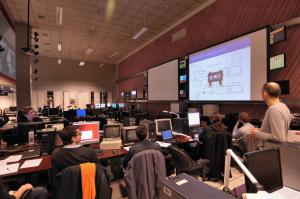Students command 100 plasma pulses, remotely
8 Mar 2012
-
Remy Guirlet, CEA
Participants in the French Master's in Fusion Science program have been hard at work since early February at the nearby IRFM (l'Institut de Recherche sur la Fusion Magnétique), participating in hands-on workshops and attending specialized lectures on magnetic fusion (see Newsline 208).
For the 2012 edition of this annual intensive program a new hands-on project was proposed: taking control—remotely—of the Czech tokamak GOLEM.
The GOLEM Tokamak, formerly CASTOR, was re-installed in 2009 at the Czech Technical University (CTU) in Prague by Dr. V. Svoboda and his students. The Czech team has implemented a reliable and user-friendly interface with the tokamak control and data acquisition systems, allowing graduate and post-graduate students to become acquainted with the operation of a small tokamak and to propose and perform experiments.
Under the supervision of Dr. Svoboda, GOLEM was (almost) exclusively in the students' hands for one week. More than 100 plasma pulses were performed. By groups of two or three, students studied plasma parameters' roles on performance and worked to optimize parameters to achieve the longest plasma. They also investigated conditioning techniques, ion mass number effects, and energy confinement time. Following data analysis and questioning, students presented the scientific results of their experiments at the end of their hands-on session.
The Master des Sciences de la Fusion is a collaborative training program sponsored by major French institutions of higher education (Aix-Marseille, Bordeaux, Nancy and Paris-Sud Universities, Ecole Polytechnique and CEA-INSTN). Next year's February gathering is expected to draw 40 students, including students from the pan-European Erasmus Mundus Master program.


